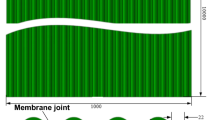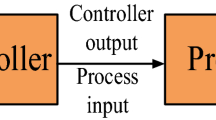Abstract
The main objective of this paper is to show the design and application on the cracking outlet temperature (COT) system using a hybrid control approach including non-minimal state-space model predictive control with an adjustable factor (AFNMSSMPC) and humanoid intelligent multimodality control (HIMMC) in two 100 k tone/year SC-1 ethylene cracking furnaces. Compared with the conventional control structure, the advanced control structure is designed based on the existing control problem. The advanced controller is developed at the platform of APC-ISYS software made by Zhejiang Supcon Company and implemented in an industrial upper computer which sets over and is connected with a CS3000 distributed control system (DCS) through OPCServer. In order to reduce the fluctuation of the COT, AFNMSSMPC is chosen as feedback controller, which guarantees system robustness together with tracking ability, and meanwhile HIMMC is as feed-forward controller based on the change in chamber temperature (measured disturbance), which can eliminate the effect on cracking outlet temperature (COT) in advance. The application results on COT of two ethylene cracking furnaces labeled M and N furnaces in practice using AFNMSSMPC-HIMMC compared to the traditional proportional–integral–differential (PID) control are presented. The standard deviation of COT reduces by 54.03% and 60.87% for M and N furnaces, respectively. The results show that the designed COT system has the capability of good tracking and strong disturbance rejection.












Similar content being viewed by others
References
Ang KH, Chong G, Li Y (2005) PID control system analysis, design, and technology. IEEE Trans Control Syst Technol 13:559–576
Chai TY, Ding JL, Wu FH (2011) Hybrid intelligent control for optimal operation of shaft furnace roasting process. Control Eng Pract 19:264–275
Che JX (2015) Optimal sub-models selection algorithm for combination forecasting model. Neurocomputing 151:364–375
Clarke DW, Mohtadi C, Tuffs PS (1987) Generalized predictive control. Automatica 23:137–160
Cutler CR, Ramaker BL (1980) Dynamic matrix control—a computer control algorithm. Proc Jt Autom Control Conf 1980:1–6
González AH, Perez JM, Odloak D (2009) Infinite horizon MPC with non-minimal state space feedback. J Process Control 19:473–481
Goodwin GC, Middleton RH, Seron MM et al (2013) Application of nonlinear model predictive control to an industrial induction heating furnace. Annu Rev Control 37:271–277
Huo AQ, Dai C, Wang YL et al (2013) Predictive control in stabilized platform based on augmented non-minimal state-space method. Comput Eng Appl 49:239–344
Jana AK (2013) Differential geometry-based adaptive nonlinear control law: application to an industrial refinery process. IEEE Trans Ind Inf 9:2014–2022
Jiang XY, Su CL, Shi HY et al (2017) Soft-measurement modeling with multi-scale evolutionary v-support vector machine for ethylene product concentration. ICIC Express Lett Part B Appl 8:1653–1661
Khalilipour MM, Sadeghi J, Shahraki F et al (2016) Nonsquare multivariable non-minimal state space-proportional integral plus (NMSS-PIP) control for atmospheric crude oil distillation column. Chem Eng Res Des 113:140–150
Ławryńczuk M (2017) Nonlinear predictive control of a boiler-turbine unit: a state-space approach with successive on-line model linearisation and quadratic optimisation. ISA Trans 67:476–495
Li HS, Zhang JM (2016) Improved PID design using new state space predictive functional control optimization based structure. Chemom Intell Lab 151:95–102
Li SF, Lim KY, Fisher DG (1989) A state space formulation for model predictive control. AIChE J 35:241–249
Li P, Li T, Cao J (2015) Advanced process control of an ethylene cracking furnace. Meas Control-UK 48:50–53
Li JN, Cai TY, Lewis FL et al (2019) Off-policy interleaved Q-learning: optimal control for affine nonlinear discrete-time systems. IEEE Trans Neural Netw Learn Syst 30(5):1308–1320
Luan XL, Min Y, Liu F (2017) Distributed pass balancing and tracking control of feed heater. Acta Autom Sin 43:1056–1064
Qin SJ, Badgwell TA (2003) A survey of industrial model predictive control technology. Control Eng Pract 11:733–764
RamýìRez M, Haber R, Peña V et al (2004) Fuzzy control of a multiple hearth furnace. Comput Ind 54:105–113
Richalet J, Rault A, Testud J et al (1978) Model predictive heuristic control: application to industrial processes. Automatica 14:413–428
Shi HY, Su CL, Cao JT et al (2015a) Incremental multivariable predictive functional control and its application in a gas fractionation unit. J Cent South Univ 12:4653–4668
Shi HY, Su CL, Cao JT et al (2015b) Nonlinear adaptive predictive functional control based on the Takagi–Sugeno model for average cracking outlet temperature of the ethylene cracking furnace. Ind Eng Chem Res 54:1849–1860
Su CL, Shi HY, Li P et al (2015) Advanced control in a delayed coke furnace. Meas Control-UK 48:54–59
Tao JL, Yu ZH, Zhu Y (2014) PFC based PID design using genetic algorithm for chamber pressure in a coke furnace. Chemom Intell Lab 137:155–161
Tao JL, Yu ZH, Zhu Y et al (2015) A linear quadratic structure based predictive functional control design for industrial processes against partial actuator failures. Chemom Intell Lab 146:263–269
Tao JL, Ma LH, Zhu Y (2016) Improved control using extended non-minimal state space MPC and modified LQR for a kind of nonlinear systems. ISA Trans 65:319–326
Tawai A, Panjapornpon C (2016) Input-output linearizing control strategy for an ethylene dichloride cracking furnace using a coupled PDE-ODE model. Ind Eng Chem Res 55:683–691
Taylor CJ, Chotai A, Young PC (2000) State space control system design based on non-minimal state-variable feedback: further generalization and unification results. Int J Control 73:1329–1345
Taylor CJ, Chotai A, Young PC (2009) Non-linear control by input–output state variable feedback pole assignment. Int J Control 82:1029–1044
Wang LP, Young PC (2006) An improved structure for model predictive control using non-minimal state space realization. J Process Control 16:355–371
Xie X, Sun W, Cheung KC (2016) An advanced PLS approach for key performance indicator-related prediction and diagnosis in case of outliers. IEEE Trans Ind Electron 63:2587–2594
Yang J, Li SH, Chen XS et al (2010) Disturbance rejection of ball mill grinding circuits using DOB and MPC. Powder Technol 198:219–228
Yin S, Zhu XP, Karimi HR (2013) Quality evaluation based on multivariate statistical methods. Math Probl Eng 3:1–10
Yin S, Liu L, Hou J (2016) A multivariate statistical combination forecasting method for product quality evaluation. Inf Sci 355–356:229–236
Young P, Behzadi MA, Wang CL et al (1987) Direct digital and adaptive control by input–output, state variable feedback. Int J Control 46:1867–1881
Zang H, Li HG, Huang JW et al (2014) A composite model predictive control strategy for furnaces. Chin J Chem Eng 22:788–794
Zhang JM (2017) Design of a new PID controller using predictive functional control optimization for chamber pressure in a coke furnace. ISA Trans 67:208–214
Zhang RD, Xue AK, Wang SQ, Gao FR (2012) Partially decoupled approach of extended non-minimal state space predictive functional control for MIMO processes. J Process Control 22:837–851
Zhang RD, Wu S, Gao FR (2017a) State space model predictive control for advanced process operation: a review of recent development, new results and insight. Ind Eng Chem Res 56(18):5360–5394
Zhang RD, Zou Q, Cao ZX (2017b) Design of fractional order modeling based extended non-minimal state space MPC for temperature in an industrial electric heating furnace. J Process Control 56:13–22
Acknowledgements
This work was supported by the National Natural Science Foundation of China under Grant 61673199, 61703191, Natural Science Foundation of Liaoning Province 20180550905 and Natural Science Fund Project of Liaoning Province 2019-KF-03-05.
Author information
Authors and Affiliations
Corresponding authors
Ethics declarations
Conflict of interest
The authors declare no conflict of interest.
Additional information
Communicated by V. Loia.
Publisher's Note
Springer Nature remains neutral with regard to jurisdictional claims in published maps and institutional affiliations.
Rights and permissions
About this article
Cite this article
Shi, H., Peng, B., Jiang, X. et al. A hybrid control approach for the cracking outlet temperature system of ethylene cracking furnace. Soft Comput 24, 12375–12390 (2020). https://doi.org/10.1007/s00500-020-04679-0
Published:
Issue Date:
DOI: https://doi.org/10.1007/s00500-020-04679-0




